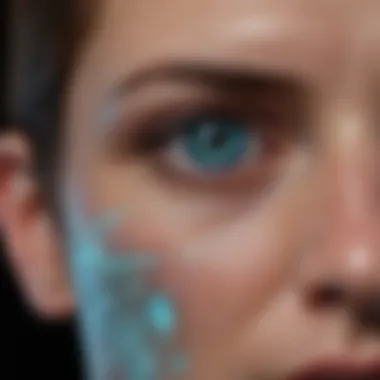Understanding Holographic Video Innovations & Applications


Intro
Holographic video technology has emerged as a transformative force across various sectors, promising new ways to visualize and interact with information. As more fields recognize the potential of this technology, it becomes crucial to understand its foundational principles, notable advancements, and diverse applications. This article explores these facets comprehensively, aiming to provide a scholarly yet accessible narrative on holographic video.
Article Overview
Purpose of the Article
The primary objective of this article is to delve into the intricacies of holographic video technology. By dissecting its technical aspects, innovations, and real-world applications, it aims to inform and engage a wide array of audiences. Understanding this technology not only enhances knowledge but also encourages critical discussions about its ethical implications and future direction.
Relevance to Multiple Disciplines
Holographic video technology intersects numerous fields such as:
- Education: Enhances learning experiences through interactive visual resources.
- Medicine: Offers new methods for surgical simulation and patient diagnosis.
- Entertainment: Revolutionizes content delivery, transforming films and concerts.
- Communication: Promises immersive interactions in business and personal contexts.
Each of these fields benefits uniquely from advancements in holographic technology, underpinning its widespread relevance in today's increasingly digital landscape.
Research Background
Historical Context
The journey of holographic video began several decades ago with foundational experiments in optics and light manipulation. Initially, holography was primarily a photographic technique. However, the advent of computing technology and advancements in optics paved the way for the development of dynamic and interactive holographic systems. Researchers have continually refined these systems, leading to today’s more sophisticated forms of video representation.
Key Concepts and Definitions
To fully grasp the intricacies of holographic video, it is essential to understand key concepts such as:
- Holography: A photographic method that records and reconstructs light fields.
- Volumetric Displays: Systems that create three-dimensional images visible from multiple angles.
- Augmented Reality (AR): A technology that overlays digital information onto the physical world.
By comprehending these terms, readers can better appreciate how holographic video technology operates and the implications it holds for future advancements.
"Holographic video stands at the cusp of innovation; it challenges our traditional perceptions of media."
"Holographic video stands at the cusp of innovation; it challenges our traditional perceptions of media."
Foreword to Holographic Video
Holographic video stands at the intersection of science, technology, and creative expression. It is a groundbreaking innovation with potential to revolutionize how we perceive and interact with visual media. This section sets the stage for a deeper dive into the fundamentals of holographic video, emphasizing its significance in various sectors such as education, entertainment, and medical imaging. Understanding holography is instrumental in recognizing its broad applications and implications.
Defining Holographic Video
Holographic video can be defined as a three-dimensional visualization technique that captures and reproduces the light field produced by an object. Unlike conventional video, which presents flat images on screens, holographic video creates a sense of depth and realism. This technology uses laser light to record the interference patterns of light reflected from a subject, allowing for lifelike images to emerge when viewed under appropriate conditions.
One major feature of holographic video is that it enables viewer interaction. This means users can change their perspective as if they are looking around the object in real time. This level of immersion has significant implications in entertainment, education, and other fields where spatial awareness enhances understanding and engagement.
Historical Context
To comprehend the advancements in holographic video, it is vital to look back at its origins. The concept of holography was first introduced in 1947 by Hungarian scientist Dennis Gabor. He envisioned a method to record and reconstruct three-dimensional images using interference patterns. His work laid the foundation for later developments, including the use of lasers in the 1960s, which enhanced the clarity and fidelity of holograms.
As technology evolved, so did holography. In the 1970s and 1980s, researchers began experimenting with holographic displays for practical applications. Over the decades, ongoing research has led to breakthroughs such as computer-generated holography. These innovations resulted in a variety of use cases across multiple industries, paving the way for holographic video as we know it today.
The importance of understanding the historical context cannot be understated. It shapes our awareness of both the capabilities of current technology and the obstacles that remain. As we delve deeper into the technical foundations and current applications, we will appreciate how history informs contemporary practices and future developments.
Technical Foundations
The technical foundations of holographic video serve as the backbone for understanding its various applications and innovations. This section breaks down the essential components of holography, which include its principles, hardware, and software techniques. Understanding these foundations is crucial, as they provide insights into how holography transcends traditional video technologies, allowing for more immersive and interactive experiences.
Principles of Holography
Holography operates on the principles of interference and diffraction of light. When a coherent light source, like a laser, illuminates an object, it creates an interference pattern on a photographic medium. This pattern encodes the light's phase and amplitude information, providing a three-dimensional representation of the object. This method differs significantly from conventional imaging techniques that capture only the intensity of light.


A key characteristic of holography is its ability to produce images with depth perception. As viewers change their angle of observation, they see different aspects of the hologram, much like they would with a real object. This capability is particularly beneficial in applications like medical imaging, where depth cues can enhance diagnostic accuracy. However, one limitation is the complex setup required for creating quality holograms, which might restrict its widespread adoption in certain fields.
Hardware Components
Laser Systems
Laser systems are indispensable in holography due to their steady and coherent light output. The coherence of a laser allows it to produce clear and detailed interference patterns, which are crucial for accurate holography. This makes lasers a popular choice among researchers and industries delving into holographic video.
A unique feature of laser systems is their ability to operate in various wavelengths. This flexibility allows for distinct applications in fields like telecommunications, where specific wavelengths enhance data transmission. However, the complexity and cost of high-quality lasers can be a drawback for some users.
Detectors
Detectors play a vital role in capturing the holographic information encoded by laser systems. They convert light patterns into electronic signals that are then processed to reconstruct the image. The ability of detectors to accurately capture subtle light variations is essential for producing high-quality holograms.
Key characteristics of modern detectors include their sensitivity to a wide range of wavelengths and quick response times. These features make detectors particularly beneficial in applications like medical imaging, where timely data processing can be critical. One disadvantage, however, is that advanced detectors can be quite expensive, which may deter smaller institutions or individual researchers.
Projectors
Projectors are the final component in delivering holographic images to viewers. They facilitate the visualization of holograms, allowing audiences to engage with the three-dimensional representations. Projectors utilize various technologies, including digital light processing (DLP) and liquid crystal on silicon (LCoS), to create vibrant images.
The unique aspect of holographic projectors lies in their ability to display images from multiple angles simultaneously. This characteristic fosters an interactive experience for viewers, making it appealing in fields like entertainment and education. On the downside, achieving high-resolution projections can require substantial investment in technology and calibration.
Software Techniques
Image Reconstruction
Image reconstruction is a critical software technique in holography. It involves algorithms that translate the signals captured by detectors back into visual images. This process is central to creating a coherent and accurate representation of the original scene.
A key factor of image reconstruction is its adaptability; it can be fine-tuned to enhance specific features of the hologram, improving clarity and depth perception. However, the computation power required for real-time reconstruction can be a limitation for smaller devices or applications.
Signal Processing
Signal processing is another fundamental technique that enables the manipulation of holographic data. It enhances the raw data collected from detectors, allowing for adjustments like noise reduction and contrast enhancement. This technique is essential for producing quality holographic images that are both visually appealing and informative.
A significant benefit of signal processing techniques is their capacity to support real-time data handling. This ability is crucial in dynamic applications such as telecommunications, where fast and reliable communication is paramount. Yet, the complexity of signal algorithms might pose challenges for users without specialized knowledge.
Holographic technologies hinge not only on advanced hardware but also on sophisticated software to fully realize their potential.
Holographic technologies hinge not only on advanced hardware but also on sophisticated software to fully realize their potential.
In summary, the technical foundations of holographic video encompass essential principles, hardware, and software components. Each plays a significant role in shaping the technology's current and future applications, with distinct benefits and limitations that warrant consideration for further development.
Current Applications
Holographic video technology is at a transformative stage, with its applications expanding in various fields. In this section, we will delve into the significant areas where holographic video is currently making an impact, exploring its functionalities, benefits, and the considerations that accompany its implementation.
Medical Imaging
Holographic video has revolutionized medical imaging. Unlike traditional imaging techniques, holography provides a three-dimensional visualization of internal structures, allowing for more accurate diagnostics. It enhances the clarity of images, giving medical professionals the ability to see organs and tissues in a more realistic manner. This is critical for complex surgeries and treatment planning.
The technology allows for real-time imaging, which can be invaluable in operating rooms. Surgeons can view and manipulate holographic images while they perform procedures, leading to better outcomes. Some systems, such as the Microsoft HoloLens, are already being used in some hospitals, offering practical applications in diagnostics and surgery.
"Holographic imaging aids in reducing errors during surgery and improving the precision of operations."
"Holographic imaging aids in reducing errors during surgery and improving the precision of operations."
This innovation not only benefits patients but also elevates the training standards for medical practitioners. With the capability to simulate procedures using holographic images, training can be more interactive and effective.
Education and Training
In education, holographic video serves as a powerful tool for enhancing learning experiences. It introduces three-dimensional models into classrooms, making complex subjects like anatomy, chemistry, and physics more tangible for students. Instead of viewing flat images, students can engage with dynamic, interactive models that deepen their understanding.
Incorporating holography into lessons can promote greater retention of information. For instance, when studying the solar system, students can observe the planets rotating in real-time, which can fundamentally change their grasp of spatial relationships.


Moreover, educators can utilize these technologies in professional training scenarios, enhancing simulations in fields such as engineering or medicine. Studies have shown that immersive learning techniques often lead to improved performance.
Entertainment and Gaming
The gaming sector has also embraced holographic video. Games that integrate holograms create immersive experiences that captivate players. For example, projects like Magic Leap focus on mixing digital content with the real world, allowing players to interact with three-dimensional characters and environments.
This innovation enhances emotional engagement, as player interaction feels more genuine when faced with lifelike holograms. Furthermore, the entertainment industry is exploring the potential of holographic concerts, where virtual performances of famous artists can occur in real-time.
The visual impact of these holograms provides a unique experience that traditional media cannot replicate, potentially transforming the landscape of entertainment.
Telecommunications
Holographic video is reshaping telecommunications by enabling more realistic virtual meetings. With this technology, participants can appear as holographic representations, making remote collaboration more lifelike. This has become crucial in global businesses where teams are often dispersed.
Remote work, intensified by recent global events, has heightened the need for effective communication tools. Holographic video allows individuals to engage in discussions that replicate the feel of in-person interactions, improving collaboration and decision-making.
As the technology evolves, we can expect significant enhancements in bandwidth and connectivity options, making holographic calls more accessible. This could further bridge distances and foster better professional relationships.
Emerging Trends
The exploration of emerging trends in holographic video technology highlights significant progress and innovation. Understanding these trends is crucial as they shape the future of how holographic video is perceived and employed across various sectors. With rapid developments in technology, holographic video stands at the intersection of creativity and functionality, pointing to a transformative future.
Advancements in Holographic Displays
Recent innovations in holographic displays are notable for enhancing the viewing experience. One key development is the creation of light field displays. These enable users to perceive depth and view objects from different angles without needing special glasses. Companies like Looking Glass Factory are at the forefront, producing displays that permit multiple viewers to see holograms from various perspectives.
Moreover, improvements in resolution and brightness have made holographic video more practical for everyday use. Traditional displays often fall short in capturing the intricacies of holographic content. As display technology advances, it becomes easier and more accessible for various applications, from marketing to education.
Integration with Virtual Reality
The integration of holographic video with virtual reality (VR) is another significant trend. This synergy enhances immersive experiences by merging real-world elements with digital content. For example, combining holographic video streams with VR can create more interactive simulations for training and education. Users find it easier to engage with content when they can manipulate virtual objects using their hands.
Such integration also opens doors to novel applications in entertainment and social interactions. Environments that incorporate both holograms and VR can facilitate remote communications, which is beneficial for long-distance learning and collaboration in workplaces.
Artificial Intelligence in Holography
Artificial intelligence (AI) is increasingly influencing holographic technology. Enhanced algorithms play a pivotal role in improving image reconstruction and real-time rendering, making it possible to deliver high-quality holographic content efficiently.
With AI, it becomes feasible to analyze vast amounts of visual data and predict user interactions with holograms. This capability can lead to more personalized experiences, tailoring content based on individual preferences or behaviors. The potential here is substantial, indicating a future where holographic interactions are not just passive viewing but active participation.
"The integration of AI with holographic technology represents a leap forward in interactivity and user engagement."
"The integration of AI with holographic technology represents a leap forward in interactivity and user engagement."
Challenges and Limitations
The exploration of holographic video technology brings into focus various obstacles and constraints that may hinder its development and widespread application. It is vital to recognize these challenges because they shape the direction in which this promising technology may evolve. Each hurdle not only poses a question for researchers and practitioners but also unfurls a discourse on what needs to be prioritized to make these advancements meaningful and ethical.
Technical Barriers
The technical barriers in holographic video involve a range of complex factors that affect video quality and user experience. Achieving high-resolution holography requires significant advancements in laser systems and detectors. The current limitations in holographic projection often include issues with depth perception and image clarity. Moreover, the technology depends heavily on the calibration of optical components.
In addition, real-time holographic video processing demands powerful computing resources. The software algorithms that handle image reconstruction and signal processing must continue to evolve to handle these workloads efficiently. Without the necessary breakthroughs in technology, the full potential of holographic video will remain unexplored.
Cost of Implementation
Implementing holographic video involves monetary considerations that can be daunting. The cost of the essential hardware, such as advanced laser setups and specialized projectors, can deter educational institutions and small enterprises from adopting this technology.
Moreover, the integration of holographic systems into existing infrastructures requires additional investments. Training personnel to operate advanced holographic equipment adds to the financial burden. For many organizations, careful cost-benefit analysis is crucial. They must weigh the technology’s potential advantages against its financial drawbacks to determine feasibility.
Health and Safety Concerns
Health and safety aspects of holographic video technology also demand attention. There are potential risks associated with prolonged exposure to laser systems, which can cause eye strain or other health complications for users. Regulatory compliance regarding safety standards becomes essential, often creating additional hurdles in product development.


In the domain of personal privacy, holographic video can raise alarms. The ability to capture and project realistic images presents a risk of misuse. Therefore, developers must also incorporate ethical considerations into their designs. There is a need for implementing safety guidelines that ensure technology is used responsibly.
"Understanding and addressing the challenges faced in holographic video is as vital as its technological advancements. Without careful navigation, the promise of this innovation may not be fulfilled."
"Understanding and addressing the challenges faced in holographic video is as vital as its technological advancements. Without careful navigation, the promise of this innovation may not be fulfilled."
In summary, grasping the challenges and limitations of holographic video is key to unlocking its full potential. Technological, financial, and health considerations must be meticulously balanced. Only then can this technology evolve to meet its prospective applications in various fields.
Ethical Considerations
The emergence of holographic video technology brings forth a myriad of ethical considerations that demand careful examination. These concerns are essential in addressing the implications of this innovative technology, especially as it impacts personal and societal dynamics. As holographic videos become prevalent, understanding the ethical landscape is crucial for responsible development and usage. Two primary aspects of ethical considerations are privacy issues and the potential misuse of technology.
Privacy Issues
The first critical point within ethical considerations revolves around privacy. Holographic video can capture and reproduce detailed three-dimensional representations of individuals and environments. This ability raises questions about consent and the ownership of one's likeness. The unauthorized capture of holographic images could lead to significant invasions of privacy. For instance, in scenarios where holograms are used without the subject's knowledge, individuals could be exploited or misrepresented.
Moreover, personal data can be linked to holographic video systems, which generates additional concerns regarding data protection. Sensitive information might be at risk if proper security measures are not enforced. Thus, it is vital for developers and institutions to establish clear guidelines regarding the consent required when utilizing holographic technology. Regulations similar to the General Data Protection Regulation (GDPR) in Europe could provide a framework to safeguard individual rights and amplify ethical standards.
Misuse of Technology
The second aspect revolves around the misuse of holographic technology. Any sophisticated tool can be appropriated for harmful purposes, and holographic video is no exception. This could manifest in various forms, such as deepfake holograms, where real people are depicted engaging in activities they never participated in. Such distortions can undermine trust in media, complicate the legal landscape, and even disrupt personal lives.
Organizations and individuals may also utilize holographic video to spread misinformation or propaganda. The ability to create hyper-realistic representations provides a powerful medium for manipulation, thereby posing risks to public opinion and social cohesion.
To mitigate these risks, developing a robust ethical framework is necessary. Engaging in dialogue among stakeholders—technologists, ethicists, policymakers, and the public—can foster a more responsible approach to holographic video usage. This collective responsibility is critical to ensure that innovations serve to benefit society rather than harm it.
"The ethically responsible development of holographic technologies hinges on the balance between innovation and respect for individual rights."
"The ethically responsible development of holographic technologies hinges on the balance between innovation and respect for individual rights."
Future Perspectives
The future of holographic video technology is at a pivotal point where it can redefine not only visual experiences but also the very fabric of our interaction with digital content. As the technology evolves, it is imperative to explore predicted developments and potential societal impacts that will shape our world.
Predicted Developments
Holographic video technology is likely to experience significant developments in the coming years. Some key anticipated advancements include:
- Enhanced Display Technologies: We expect improvements in holographic display technology, making them more accessible and affordable for consumers. The evolution from bulky systems to lightweight and portable devices will broaden the market reach.
- Integration with AI: Artificial intelligence will play a role in enhancing holographic video. By utilizing machine learning to optimize image processing, holographic displays can provide personalized viewing experiences based on user preference.
- Holodeck Experiences: Innovations could lead to the creation of virtual environments, akin to a holodeck. This would enable users to physically interact with digital representations, fostering immersive experiences in gaming, education, and other fields.
- Cloud-Based Holography: With increased internet speeds, cloud-based holographic solutions may become commonplace. Users could stream holographic content as easily as today’s video streaming services, allowing for real-time collaboration across distances.
In summary, these developments not only promise enhanced user experiences but also the democratization of holographic technology.
Potential Societal Impacts
The societal implications of holographic video technology are extensive, ranging from enhancements in various industries to ethical concerns. Some important potential impacts include:
- Education: Holographic technology can revolutionize educational methods. By providing interactive 3D models, students may have a deeper understanding of complex subjects. For instance, a biology class may allow students to visualize and interact with a 3D model of a cell.
- Healthcare: In medical training and patient care, holography could facilitate precise surgical simulations, allowing medical professionals to practice and plan complex procedures.
- Impact on Communication: Holographic video can enhance communication, offering lifelike interactions in remote settings. Virtual meetings could evolve into immersive environments where participants feel as though they are present in the same space.
- Ethical Concerns: The misuse of this technology raises ethical issues such as privacy violations and misinformation. There is a risk that holograms could be used to create realistic forgeries or manipulate public opinion.
"As we look toward the horizon, the ethical dimensions of holographic technology demand careful consideration as it integrates deeper into society."
"As we look toward the horizon, the ethical dimensions of holographic technology demand careful consideration as it integrates deeper into society."
Culmination
The exploration of holographic video technology represents a critical juncture in modern advancements. This topic is extremely relevant as it merges the realms of science, technology, and ethics, painting a comprehensive picture of how holography affects both our current landscape and future potential.
Summary of Key Points
In recapping the central themes of this article, several key points emerge:
- Definition and History: We began by establishing what holographic video is and how it has evolved over time, cutting through the complexities that define it.
- Technical Underpinnings: The principles guiding holography, along with the necessary hardware components such as laser systems and projectors, laid the groundwork for understanding its functionality.
- Current Applications: The integration of holographic video in fields like medical imaging, education, and entertainment illustrates its versatility and broad impact.
- Emerging Trends: Innovations like AI integration and advancements in display technology indicate a bright future for holographic video.
- Challenges Ahead: The article also outlined the various obstacles, such as technical barriers and ethical considerations, that must be navigated.
- Future Perspectives: Finally, we contemplated potential societal impacts and developments that could redefine our engagement with digital content.
By synthesizing these elements, the article highlights the multifaceted nature of holographic video technology.
Call for Continued Research
The field of holographic video is still in its infancy. Ongoing research is essential for unlocking its full potential. Several areas nedd deeper exploration, including:
- Improvement of Display Technologies: Innovations in holographic displays can significantly enhance user experience.
- Application Studies: More practical applications need thorough investigation, especially in diverse sectors where holography could add value.
- Ethical Frameworks: As the technology advances, establishing ethical guidelines for its use will be crucial in mitigating privacy concerns and preventing misuse.



